Throughout the two weeks I spent within the Galápagos—a gaggle of 15 islands on the equator, about 500 miles west of Ecuador—I shot greater than 8,000 pictures, saved lower than 300, and am now sharing 12 of them for this weblog. The prolonged photo-essay format can work nicely as an internet gallery on a single topic akin to this one, and even as a self-published photographic e book.
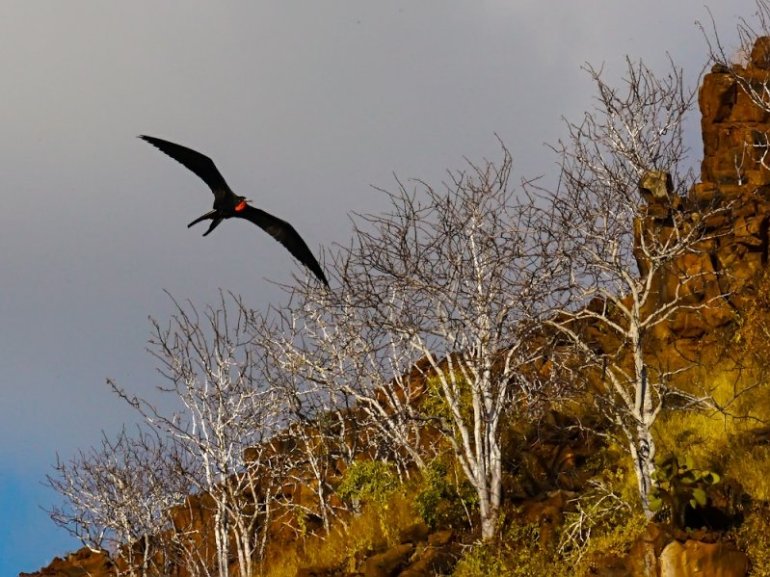
Flying Frigatebird | Punta Carrion, Isabela Island
The good inflated pink throat pouch attracts the attention into this picture. The pouch is also designed to draw a possible mate. There have been many Frigates drifting alongside the hills, utilizing their seven-foot huge wingspans to experience the air currents and soar over the stands of palo santo timber that coated this space. The power of this picture comes from the dueling diagonal thrusts of the wing angle and the contrasting slope of the hill.
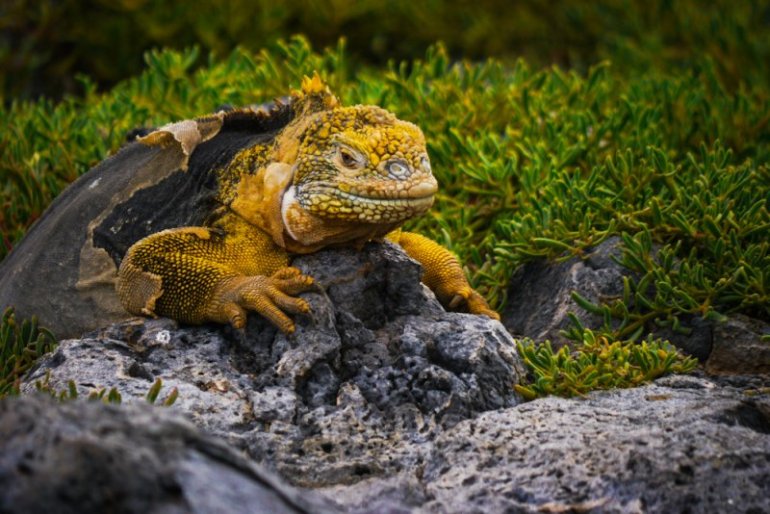
Molting Land Iguana | South Plaza Island
This closeup of a land iguana speaks of the prehistoric previous. This one is molting—I may see its pores and skin peeling away from its again. I observed many photographers taking footage of those iguanas from a standing place, which diminishes them in scale and de-emphasizes expression. I moved my digicam as low to the bottom as doable, and framed the picture in my fold-out LCD viewfinder, stressing the emotionless expression and the impact of the peeling pores and skin.
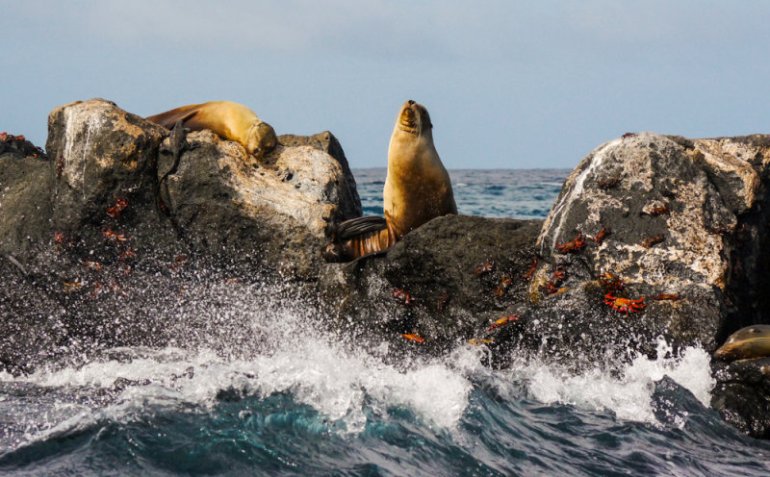
Sea Lions and Crabs | Santa Fe Island
These rocks had been a couple of half-mile offshore of Santa Fe Island. I framed the picture so the foreground was wealthy in waves and spray that bathe the rocks behind them. The rocks are coated with pink Sally Lightfoot crabs. Two Galápagos Sea Lions appear to personal these rocks—one sleeps whereas the opposite stands guard. Life in and across the Galápagos resides on each land and sea, and locations akin to this symbolize a mix of each. I used to be taking pictures from a raft that was being tossed about by the waves. So as to stabilize this 200mm focal size shot, I had to make use of a shutter pace of 1/2000th of a second—ten instances sooner than regular so as to keep away from blur on account of digicam shake.
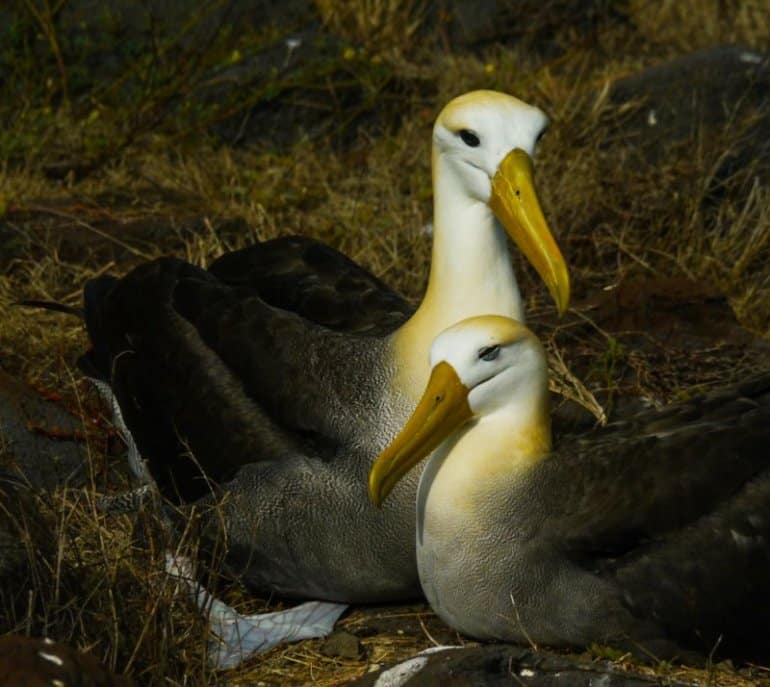
Nesting Waved Albatrosses | Punta Saurez, Espanola Island
The only nesting floor for Waved Albatrosses is right here on Espanola Island. It’s huge, accommodating over 12,000 pairs at a time. The scene is chaotic, and calls for photographic simplification. I selected to focus on only one pair, and made this household portrait as one member of a pair sits on the nest within the foreground whereas the opposite looms over it within the background. The female and male break up the following sitting duties, so I used to be unable to establish the gender roles right here. However that isn’t necessary—as an alternative, I attempt to specific the bond between the 2 as outlined by their deliberate positioning and the matching placid expressions that inform the story of nesting albatrosses. I additionally stress the delicate yellow feather coloring that matches the colours of their beaks.
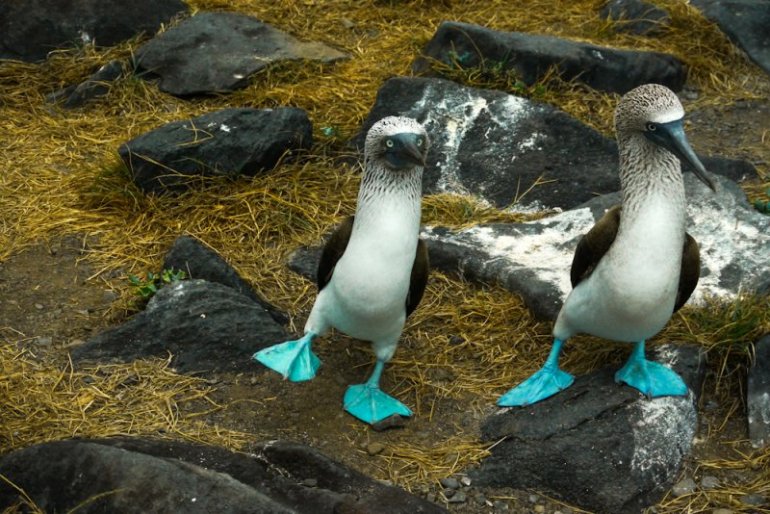
Dancing Blue Footed Boobies | Punta Saurez, Española Island
The habits of the blue footed booby is most clown-like throughout courtship. It appeared to me that this pair was engaged in a courtship dance, as they shuffled their enormous blue toes backward and forward, just about mimicking one another’s strikes. I photographed them above, one thing I hardly ever do with birds, since a excessive vantage level usually tends to decrease them in scale. However on this case, an overhead viewpoint was warranted—I’m able to stress the colour and place of the toes, which inform the story right here.
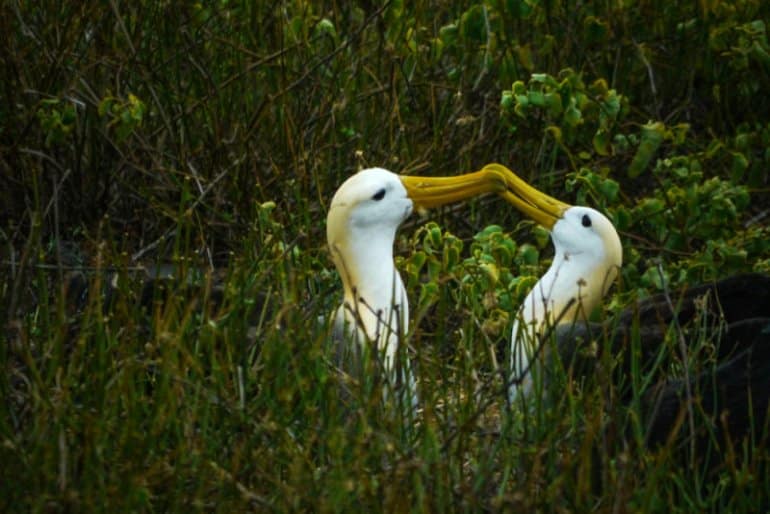
Mating Waved Albatrosses | Punta Suarez, Espanola Island
Our go to to Española Island was capped by this chance—permitting me to seize what seems to be a gesture of affection expressed by a pair of waved albatrosses throughout its mating dance. Solely the heads and necks are seen, as they emerge from the tangle of vegetation to affix beak suggestions with a delicate tapping sound. Wildlife pictures can usually specific human values, although the topics themselves will not be human. This picture affords a superb instance of this. As human beings, we are able to see and really feel and perceive a common gesture akin to this one, incongruously expressed by creatures fairly in contrast to ourselves. This gesture is not any extra or at least a kiss—a token of affection anybody can relate to.

Panorama and Path | Central Highlands, Santa Cruz Island
The facility of panorama pictures rests largely within the relationship between gentle, colour, and composition. On today, the sunshine was flat, providing no emphasis. But this panorama, comprised of the highest of an commentary tower in a tortoise habitat within the hills of Santa Cruz Island, nonetheless works nicely. The saturated greens energize the picture. I composed the picture across the brown path operating from the foot of our commentary tower to the forest within the mid-distance. That forest, in flip, factors the attention in direction of the distant hills within the background, and the grey sky, tinged with blue, frames the picture on the prime.
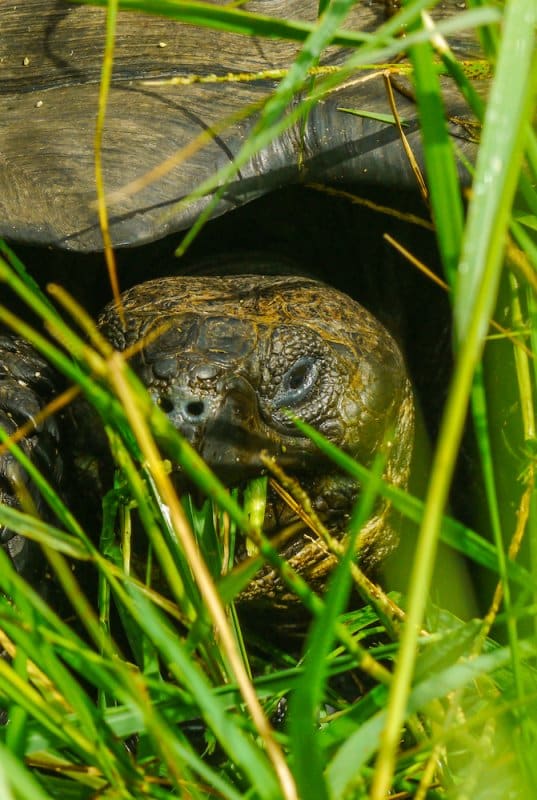
Galápagos Big Tortoise | Cerro Mesa Plantation, Santa Cruz Island
About 3,000 Galápagos Big Tortoises reside within the wild on the huge espresso and banana plantations within the highlands of Santa Cruise Islands. We needed to hike for a half hour to seek out this one having lunch within the excessive grasses of Cerro Mesa Plantation. I’m not fascinated about describing the looks of a complete tortoise. As an alternative, I zoom in on the purpose of the picture—the style of grass. It’s believed that these reptiles can reside as much as 150 years within the wild. Probably the most well-known tortoise within the Galápagos, referred to as Lonesome George, died in captivity at Santa Cruz’s Charles Darwin Analysis Heart the day after we visited the middle. (I didn’t {photograph} him as a result of he was just about obscured by the bushes in his pen.)
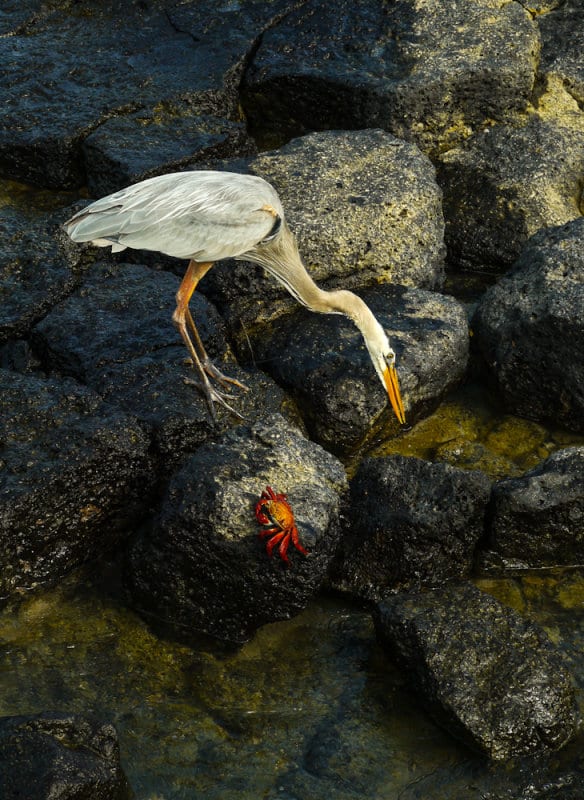
Nice Blue Heron and Sally Lightfoot Crab | Santa Cruz Island
These giant herons are seen on the seashores and lagoons of most islands within the Galápagos. I returned with quite a few images of them in flight, stalking by the surf, and perched on the ledges of their rocky dens. I made this picture, nonetheless, beneath strikingly totally different circumstances, and it proved to be my most expressive Nice Blue Heron picture of your complete go to. I by no means anticipated to seek out this magnificent chook standing on the rocks adjoining to the busiest location within the largest city in your complete Galápagos. But there it was—perched subsequent to a boldly contrasting Sally Lightfoot crab on the primary entrance to crucial pier within the Galapagos, the pier the place the entire vacationers visiting Puerto Ayora by sea arrive and go away from their ships and boats. I used to be spending a couple of hours alone within the city and devoted a full half-hour to watching this chook transfer round these rocks. When it leaned ahead, virtually as if it had been concerning the converse with the crab, I made this picture. It speaks of coexistence between varied species—each the crab and the heron feed off these identical rocks and the ocean round them and share the house in mutual respect. This picture reveals us that expressive pictures might be made beneath all circumstances, even these the place we would least look forward to finding them.
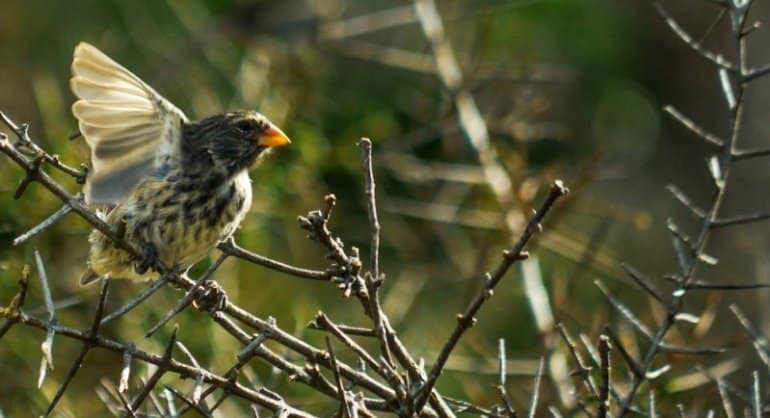
Feminine Vegetarian Finch | Urbina Bay, Isabela Island
There are 13 species of finches within the Galápagos, collectively referred to as “Darwin’s Finches.” No different group of creatures is as necessary to find out how now we have come to know our place in our world. And all due to Charles Darwin’s voyage to the Galápagos on the HMS Beagle in 1835. Whereas all of these species are totally different from one another, Darwin concluded that each one of those little brown and black birds had been additionally comparable, and had descended from a typical ancestor on account of isolation and lack of predation. Darwin’s conclusion has been confirmed by fashionable DNA testing, and makes it doable for us to see how life itself has developed and advanced. These finches are on the very essence of the Galápagos story, and we noticed totally different species on the assorted islands we visited. Finches are very troublesome to {photograph}, since they’re small birds which might be always on the transfer, and infrequently screened from view by timber and bush branches. Nevertheless, I used to be lucky to make at the least one expressive picture of a “Darwin Finch,” which I’ve recognized as a feminine Vegetarian Finch. Its chest and head markings are unmistakable, and I caught it with one in all its wings fluttering and its translucent beak illuminated by backlight.
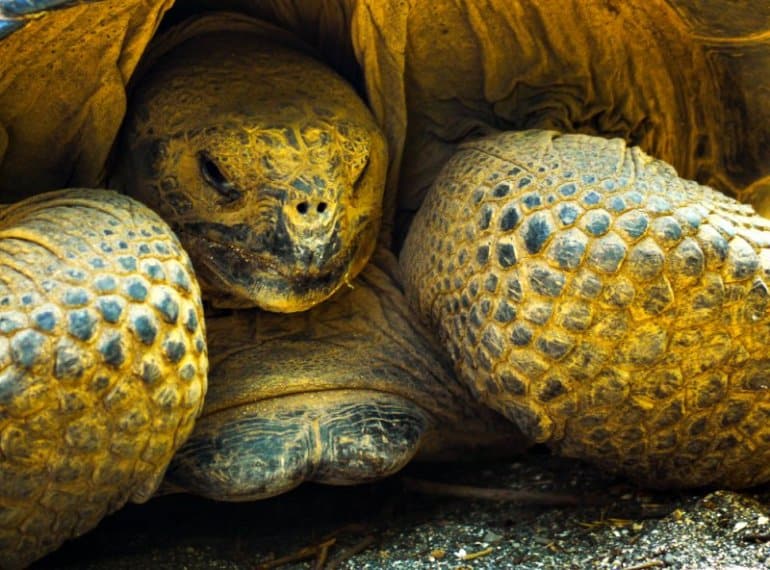
Galápagos Tortoise | Urbina Bay, Isabela Island
Whereas the finch often is the most important creature within the Galápagos, the 15,000 tortoises that roam the islands are among the many most original. I’ve tried to precise simply how distinctive they’re on this close-up picture of a tortoise, made because it was drawing its head again beneath its protecting shell. The armored treads on its enormous legs inform us that these tortoises transfer not solely by foot, but additionally by knee and thigh. There may be additionally armor on the chest, and naturally, it carries a large shell on its again. Maybe all of this safety is why a few of them have lived to be 150 to 200 years outdated.
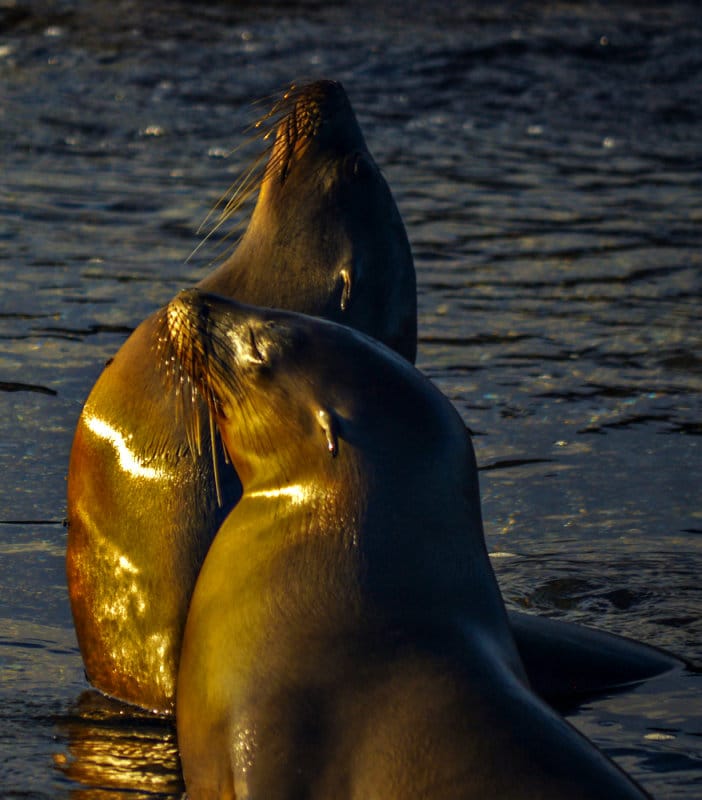
Sea Lions | Punta Espinosa, Fernandina Island
This pair of feminine Galápagos Sea Lions gave the impression to be posing for the cameras as they basked within the night solar on the water’s edge. They’re large—sea lions are the most important animal on land within the Galápagos. There are someplace round 50,000 sea lions within the Galápagos, principally discovered on its sandy seashores. They’re nicely tailored to people, and infrequently are the primary creatures to welcome vacationers as they clamber ashore. This specific pair, which I photographed facet by facet in profile, one with its nostril to the sky, the opposite with its nostril to the seashore, symbolizes the maintain sea lions have on the human creativeness. We research this picture and surprise what they should be pondering at this second.
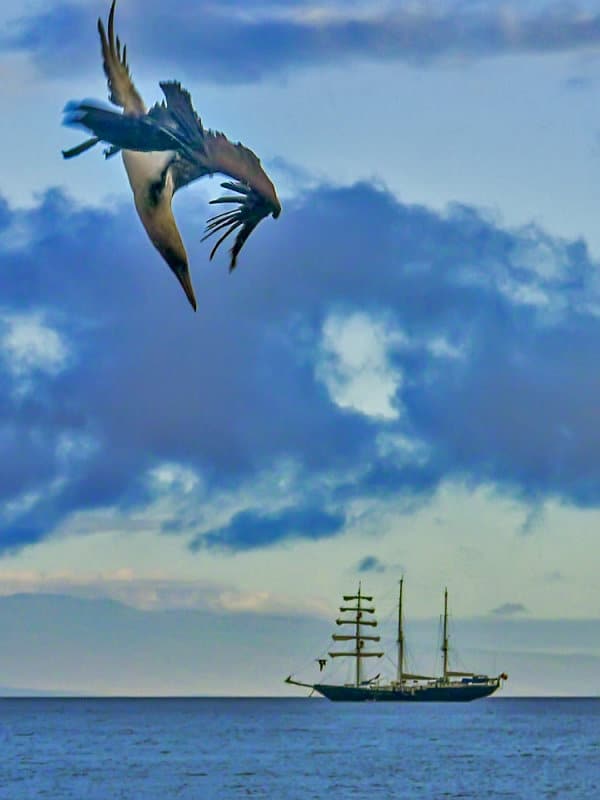
Diving Blue Footed Booby | Espumilla Seaside, Santiago Island
Espumilla Seaside, an necessary nesting website for sea turtles, can be a kind of magical locations the place Galápagos sea birds frequently feed. Considered one of my pre-trip targets was to {photograph} a diving blue footed booby about to strike the water, and this seashore proved to be the most effective place within the Galápagos to do it. These birds soar excessive into the air, spot a fish, and plunge straight right down to the ocean, coming into the water like a knife. It’s a very troublesome {photograph} to seize—to border, expose, and deal with a plunging chook takes nice talent and a great deal of luck. I additionally wished a well-composed picture, one with out a variety of clean sky or empty water as context. I spent a half-hour right here, taking pictures a number of hundred footage of diving boobies so as to make this specific picture. (Fortunately, I used to be granted the posh of time right here—our group was climbing on the island, and our information made it doable for me to remain behind on the seashore, accompanied by one in all our boatmen, so as to focus solely on photographing diving boobies.)
I used my smaller digicam, zoomed to its most focal size of 90mm, to get this shot. It allowed me to position our group’s ship, the barquentine Mary Anne within the background, in addition to add a layer of clouds between the ship and the ocean. The birds had been plunging by my body frequently, and I used a quick shutter pace of 1/800th of a second to freeze this one simply because it started to furl its wings and retract its toes so it may enter the water with the least resistance. Its physique was already stretched out to its restrict. I used to be in a position to place the chook within the higher left-hand nook of the body to counterbalance the crusing ship within the decrease right-hand nook, making a diagonal composition. It took each time and a variety of “misses” to make this {photograph}, however the consequence was nicely definitely worth the effort.
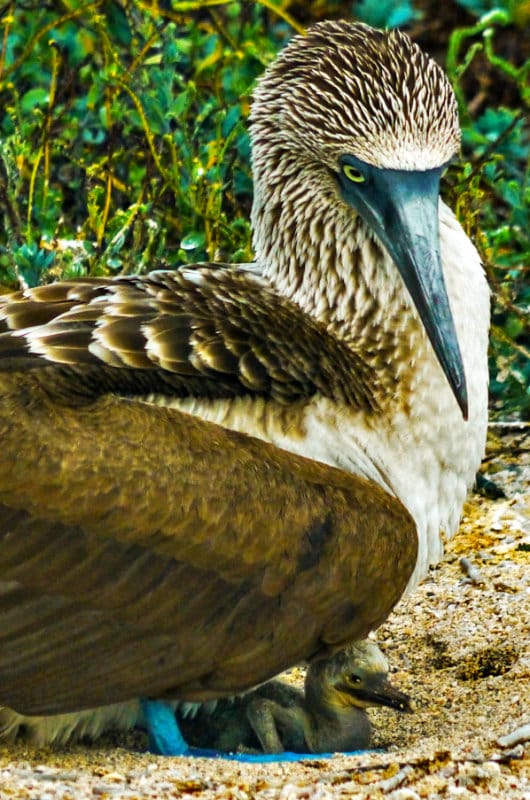
Mom and chick | Seymour Island
As I roamed Seymour’s enormous nesting colony of blue footed boobies, I discovered one cradling a tiny chick between her giant blue toes. Due to the scale distinction, the attention goes first to the big grownup chook because it casts a watch over its sharp blue invoice pointed downwards in direction of the chick. The invoice acts as a pointer, and following its move, we come to the tiny chick, resting comfortably beneath the nice brown feathers of its mom’s wing. This picture is all about scale incongruity. It was additionally a troublesome shot to make. I needed to play with about twenty pictures till I used to be in a position to get one with each the mom’s invoice pointing downwards and the chick’s physique seen.
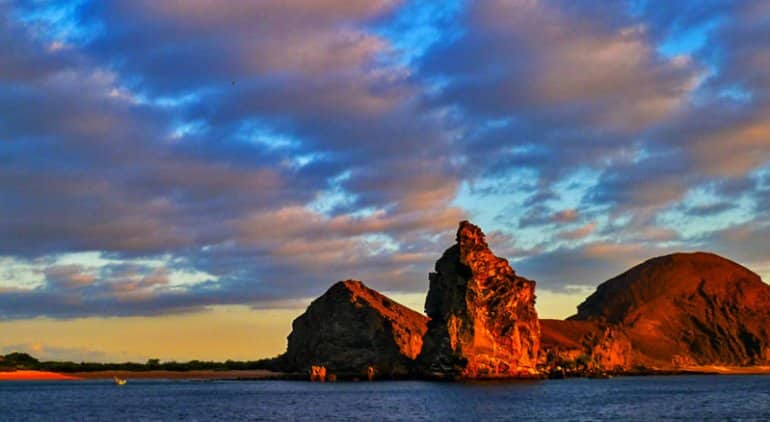
Pinnacle Rock at Sundown | Bartolomé Island
Probably the most well-known promontory within the Galápagos is bathed within the golden gentle of a mirrored sundown, which makes a stupendous topic for {a photograph}. I often keep away from taking footage of well-known locations, as a result of they usually resemble postcards. What makes this scene so particular is the set of three cloud streams that appear to blow up from not solely Pinnacle Rock itself but additionally from the 2 enormous hills that flank it on both facet. I place the waterline close to the underside of the body to extend the size of these cloud streams, all of which replicate traces of the setting solar as nicely.
